[ad#300]
Now more often than ever hobbyists are choosing to build planted vivariums over traditional enclosures. The advantages of a vivarium are tremendous: there’s often much, much less upkeep, they look nicer, and generally herps prefer the extra hiding, climbing, and breeding spaces provided. They have truly begun to take off in popularity on the reptile side of the hobby over the past couple of years as the advantages have become more apparent. When set up properly, quick upkeep should be nothing more than cleaning the glass. While many hobbyists have a firm grasp on the needs of the herps they keep, they might not be completely confident choosing flora (plants) for their vivarium.
[ad#sponsor]
Choosing the Flora
Choosing the right flora for a jungle or forest vivarium is absolutely key to the success of the contained ecosystem. It depends very heavily on the type of animal you’ll be keeping. Different gecko species call for different humidity levels, lighting, temperatures, and more. Furthermore, each gecko species has different enclosure size requirements! It’s very important to keep growth rate and size, conditions, and general “toughness” in mind while choosing flora. Getting into details on every possible plant combination for each enclosure size would make for one massive article, so here’s a quick and simple list of some commonly available gecko vivarium appropriate plants.
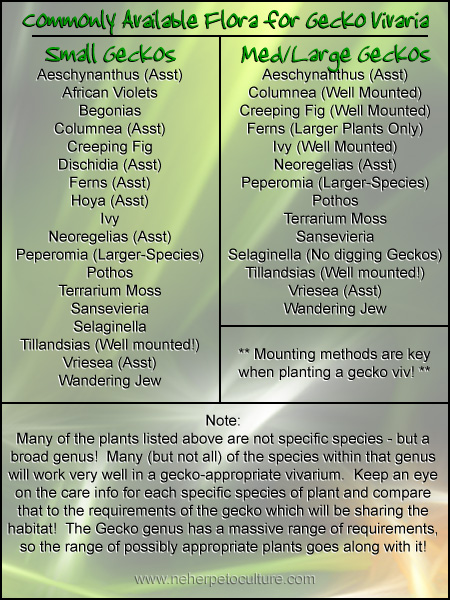
Planting
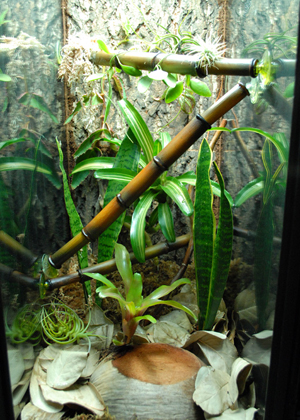
Once you’ve figured out the appropriate plants for your gecko’s vivarium you’ll need to go about planting them. Different plants require different substrates, so I’d suggest figuring out which plants you’ll be using before adding substrate. An example of a proper vivarium substrate is a mix of coco, orchid bark, and sphagnum moss. Straight coco often holds too much moisture allowing plants to rot. Be sure to follow each plant’s requirements closely!
To clarify: the substrate should be the last of three parts in building the bottom layers of a vivarium: clay balls (ie hydroton, hydroballs, etc), a screen separator, and then whichever substrate you use on top.
Click to Enlarge
Mounting Plants
When mounting an epiphyte (air plant) or climber, there are a few different ways to go about it. We usually use either hot glue or toothpicks depending on the type of plant. Toothpicks can be pushed into cork or foam backgrounds easily, allowing a better mounting spot. Tillandsias or Bromeliads with very short stems can be hot glued into place, and if done carefully the hot glue won’t be seen! Some people use florist wire as well. Just be careful about leaving sharp edges exposed! Generally, once mounted, most climbers and bromeliads will throw gripping roots to better hold onto the mounting surface. Many Neoregelias will simply need a small hole for the stem to be inserted for proper mounting.
Choosing a Ground Cover
Everyone likes the look of a nice green carpet of moss, but it’s not always the best choice for a functional vivarium. Leaf litter is usually the absolute best choice for maintaining micro fauna levels in a vivarium, and micro fauna is in my opinion one of the most important factors in building a proper vivarium. (We’ll get into that in another article!) Impaction is always a concern for any insectivorous gecko owner. For this reason, use leaf litter that corresponds to the size of your gecko! Geckos that eat MRP or prepared diets don’t need to worry as much about that since they will not be catching insects on the leaf litter and potentially getting a mouthful of it. We usually mix a patch or two of moss with leaf litter for a mix of form and function. Dried mosses are OK but live moss is best. When acclimating moss it’s very important to keep it moist for the first few weeks. If moss is allowed to dry it’s very difficult to get most types to reanimate.

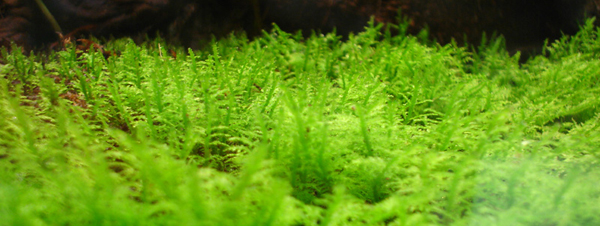
Processing Flora
This is an important step which is often overlooked when building a vivarium. Processing a plant should especially be done when purchasing from a garden center or anywhere else where harsh pesticides and fertilizers are used. Most online terrarium plant suppliers take steps to ensure there are no harmful chemicals introduced to the plants they sell, but processing is a good practice when buying from any source. It only takes around 5 minutes to protect your vivarium!
Suggested processing solution for non-sensitive flora:
- 1-cup bleach per 1-gallon of water
- Soak for 3 minutes & rinse thoroughly afterward
Suggested processing solution for sensitive non-epiphytic flora:
- Rinse well under a faucet and inspect it closely
- Remove all dirt from roots and rinse very well before adding it to the vivarium
Suggested processing solution for sensitive air plants:
- Submerge in water overnight
- Inspect closely before adding it to the viv
When treating some plants (namely moss) with bleach, a little touch of color may be lost but should return within a couple weeks. Don’t let that discourage you! Co2 treating also works and is generally the safest and gentlest way to process plants, but is usually price prohibitive unless you can find inexpensive dry ice in your area!
Maintenance
After all this, the most important part is maintaining the plants! Be sure to keep everything properly watered under good lighting. We suggest 6500K bulbs to keep plants looking bright and healthy, but 6500K and 4500K bulbs have been mixed simultaneously with good results also. Again, light intensity depends completely on the type of plant you choose so follow each species’ care guide carefully. UVB bulbs are not necessary for plants although your gecko may do better with one depending on the species you are working with. As for fertilizing, the vivarium inhabitant’s waste usually does the trick!



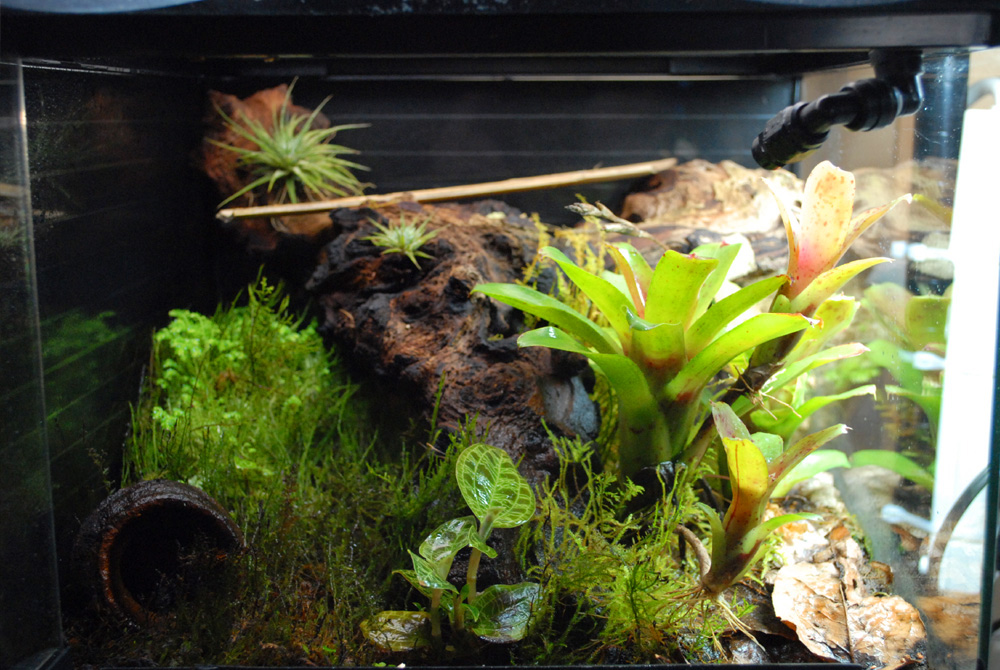
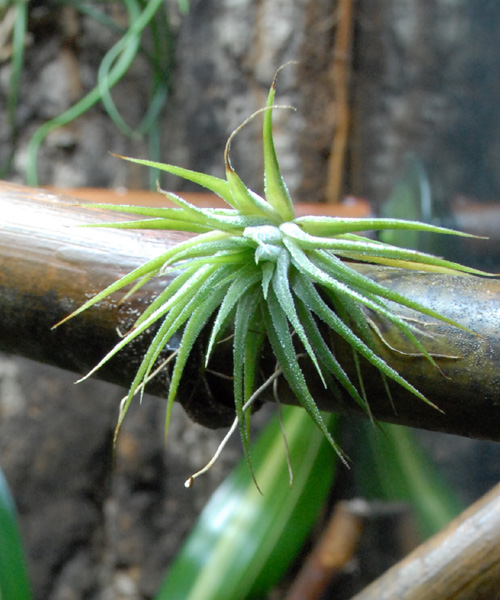
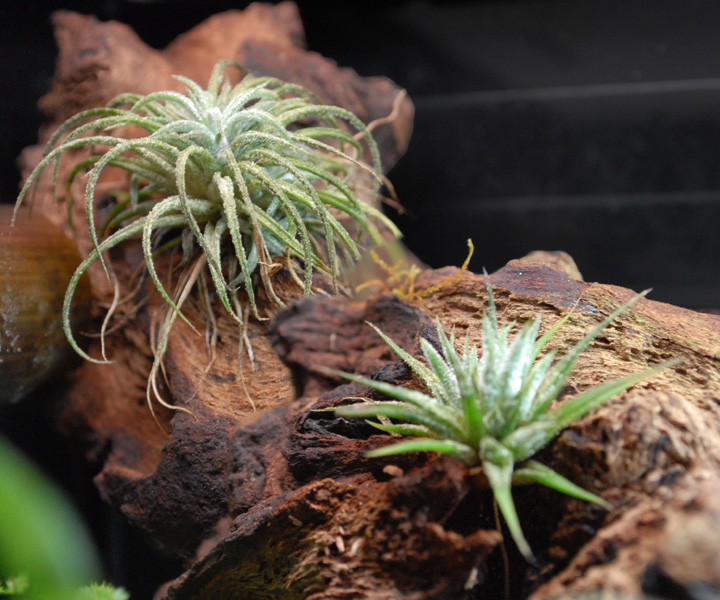

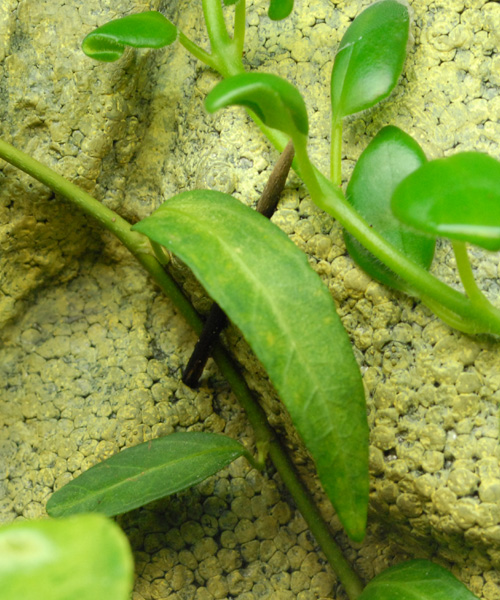
When I was living in my parents house I breed super worms in my bedroom and never smelled them. Now crickets on the other hand! I stopped breeding those really fast.
Thanks Mike for the great read. I’ve been working on a new Viv setup and was struggling with the decision of what to include and what not to include. Thanks to your article I think I now feel confident enough to proceed.
Peace and thanks again!
The Reverend LzzrdBoy
Am very in to naturalistic planted vivs
This article is grade!!
a cheap method and easy way to obtain co2 is go to wal-mart or other department store, and in sporting center they sell co2 in cartridges form either for air-soft or BB guns.
(WARNING VERY DANGEROUS CAN CAUSE DEATH IF CART ESCAPES !!!!) make a bullpen and secure it down so it can not move, and then pierce the tip of cart and trap gas with plant(VERY VERY DANGEROUS !!!!!)).
“SMARTEST WAY” spend around 15 -20$ on co2 PC keyboard blower you want the one that use co2 carts just like co2 carts for BB guns this is safest way to acquiring the gas, and this way you do not take risk of killing off your plant by soaking in bleach.